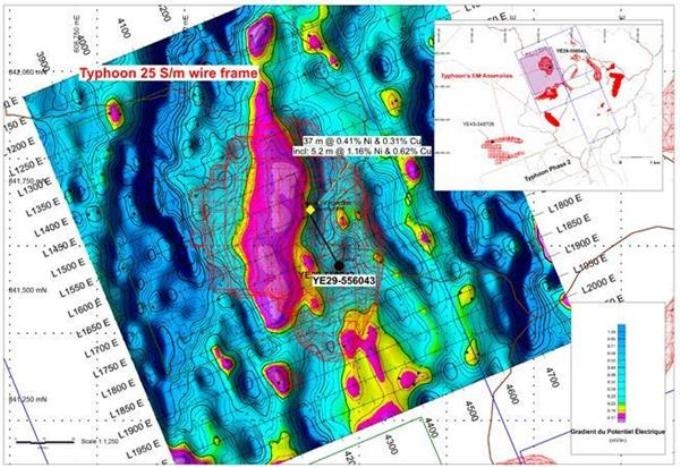Mar 13 2019
Sama Resources Inc. reports results from a downhole geophysical survey conducted on the first deep drill hole at the 100%-owned Yepleu Nickel-Copper-Cobalt-Palladium Project in Côte d’Ivoire, West Africa.
 Surface map showing Mise-a-la-Masse results that coincide with the Typhoon’s anomaly wire frame. (Image credit - Sama Resources Inc.)
Surface map showing Mise-a-la-Masse results that coincide with the Typhoon’s anomaly wire frame. (Image credit - Sama Resources Inc.)
In early March 2019, Sama Resources carried out a downhole geophysical survey at the first deep hole drilled in December 2018 (YE29-556043). The survey used a geophysical system known as “Mise-a-la-Masse” to follow-up on the mineralized intersection reported on February 14th, 2019. The “Mise-à-la-Masse” technique injects electric current into a mineralized zone intersected by drilling. It targets to assist in delineating the mineralized zone and is based on mapping the distribution of electric potential lines measured in boreholes or on the surface. SAGAX Africa SA based in Ouagadougou, Burkina Faso, finished the survey.
Findings from the Mise-a-la-Masse survey match precisely with the preliminary Typhoon™ electromagnetic geophysical survey (Typhoon) interpretation in terms of location and size of the conductive target.
So as to rapidly test the combined Typhoon/Mise-a-la-Masse targets, Capital Drilling will mobilize a second drill rig to match the one on the existing 6,000-m drilling program engineered to test high-conductivity targets established by Phase 1 of the Typhoon survey. The drilling program is targeting semi-massive and massive polymetallic sulfide anomalies situated between 600 m and 900 m from surface.
The first deep drill hole (YE29-556043) intersected semi-massive sulfide mineralization with a collective 5.2 m intersection grading 1.16% nickel, 0.62% copper, 0.24 gram per ton (gpt) palladium, and 0.21 gpt platinum (using a cut-off-grade of 0.8% nickel) within a greater interval of 37 m of disseminated sulfide mineralization grading 0.41% nickel, 0.31% copper, 0.23 gpt palladium, and 0.17 gpt platinum. The mineralization seen in the hole is characterized by aggregates of the copper, nickel, and iron sulfides pentlandite, chalcopyrite, and pyrrhotite, respectively. Pentlandite occurs along with pyrrhotite, while the chalcopyrite is either mixed with the pentlandite and pyrrhotite or occurs as late millimetric to centimetric sulfide veins cross cutting the pentlandite and pyrrhotite. Connections between the semi-massive sulfides and the mineralized pyroxenite and gabbroic host rocks are uneven but sharp and frequently show brecciated textures. This specifies that these sulfide lenses have interloped the host rocks and originated from a source that is still to be exposed.
The first drill rig carries on advancing on hole YE45-348726 aimed at testing an electromagnetic response situated 3.1-kilometer south-west from hole YE29-556043. The Typhoon response starts at approximately 750 m from surface, with a core at 950 m, and seems to be open at depth.